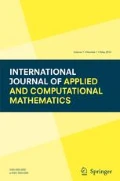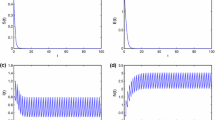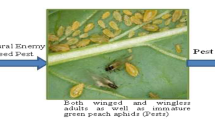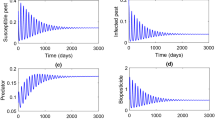Abstract
In this paper, the dynamics of a pest-natural enemy model with impulsive diffusion of pest in two patchy habitat is studied by considering the disease in pest population with two classes: susceptible, infectious and the disease is transmitted from infected pest to susceptible pest and does not propagate to the natural enemy. To reduce the pest at a desired level, the infected pest and natural enemy are impulsively released in both the patches. In the analysis, it is obtained that the susceptible pest free periodic solution is locally asymptotically stable by exploiting the Floquet theory of impulsive differential equation and small amplitude perturbation skills. It is also globally asymptotically stable using comparison techniques of impulsive differential equations. The study shows that the infection incidence rates and impulsive techniques play an important role on the dynamics of pest control system. Moreover, a short impulse period and large releasing amount of infected pest and natural enemy are cause the extinction of pest population. Finally, numerical simulations are carried out to validate our theoretical findings.






Similar content being viewed by others
References
Aimar, V., Borlengo, S., Motto, S., Venturino, E.: A meta-epidemic model with steady state demographics and migrations saturation. In: Numerical Analysis and Applied Mathematics ICNAAM 2012: International Conference of Numerical Analysis and Applied Mathematics, vol. 1479, pp. 1311–1314. AIP Publishing (2012)
Aimar, V., Borlengo, S., Motto, S., Venturino, E.: Landscape disruption effects in a meta-epidemic model with steady state demographics and migrations saturation. arXiv preprint arXiv:1403.4470 (2014)
Bainov, D.D., Simeonov, P.S.: Impulsive Differential Equations: Periodic Solutions and Applications. Longman, Harlow (1993)
Belocchio, D., Cavoretto, R., Gimmelli, G., Marchino, A., Venturino, E.: The principle of competitive exclusion in metapopulation models. AMIS 9(4), 1739–1752 (2015)
Bianco, F., Cagliero, E., Gastelurrutia, M., Venturino, E.: Metaecoepidemic models: infected and migrating predators. Int. J. Comput. Math. 89(13–14), 1764–1780 (2012)
Cagliero, E., Venturino, E.: Ecoepidemics with infected prey in herd defence: the harmless and toxic cases. Int. J. Comput. Math. 93(1), 1–20 (2016)
Debach, P., Rosen, D.: Biological Control by Natural Enemies. Cambridge University Press, Cambridge (1991)
Dhar, J., Jatav, K.S.: Mathematical analysis of a delayed stage-structured predator-prey model with impulsive diffusion between two predators territories. Ecol. Complex. 16, 59–67 (2013)
Georgescu, P., Zhang, H.: An impulsively controlled predator-pest model with disease in the pest. Nonlinear Anal. Real World Appl. 11, 270–287 (2010)
Hui, J., Chen, L.S.: A single species model with impulsive diffusion. Acta Math. Appl. Sin. Engl. Ser. 21(1), 43–48 (2005)
Jatav, K.S., Dhar, J.: Hybrid approach for pest control with impulsive releasing of natural enemies and chemical pesticides: a plant-pest-natural enemy model. Nonlinear Anal. Hybrid Syst. 12, 79–92 (2014)
Jiao, J.J., Chen, L.S., Yang, X., Cai, S.: Dynamical analysis of a delayed predator-prey model with impulsive diffusion between two patches. Math. Comput. Simul. 80, 522–532 (2009)
Lakshmikantham, V., Bainov, D.D., Simeonov, P.S.: Theory Impuls. Differ. Equat. World Scientific, Singapore (1989)
Luff, M.L.: The potential of predators for pest control. Agric. Ecosyst. Environ. 10(2), 159–181 (1983)
Quaglia, G., Re, E., Rinaldi, M., Venturino, E.: A two-patch predator–prey metapopulation model. East Asian J. Appl. Math. 2(03), 238–265 (2012)
Shao, Y.: Analysis of a delayed predator–prey system with impulsive diffusion between two patches. Math. Comput. Model. 52, 120–127 (2010)
Shi, R., Chen, L.: An impulsive predator-prey model with disease in the prey for integrated pest management. Commun. Nonlinear Sci. Numer. Simul. 15(2), 421–429 (2010)
Shi, R., Jiang, X., Chen, L.: A predator-prey model with disease in the prey and two impulses for integrated pest management. Appl. Math. Model. 33(5), 2248–2256 (2009)
Sun, S., Chen, L.: Mathematical modelling to control a pest population by infected pests. Appl. Math. Model. 33(6), 2864–2873 (2009)
Tan, Y., Chen, L.: Modelling approach for biological control of insect pest by releasing infected pest. Chaos Solitons Fractals 39(1), 304–315 (2009)
Venturino, E.: Simple metaecoepidemic models. Bull. Math. Biol. 73(5), 917–950 (2011)
Venturino, E.: Metaecoepidemic models with sound and infected prey migration. Math. Comput. Simul. 126, 14–44 (2016)
Wei, C., Chen, L.: Eco-epidemiology model with age structure and prey-dependent consumption for pest management. Appl. Math. Model. 33(12), 4354–4363 (2009)
Xiang, Z., Li, Y., Song, X.: Dynamic analysis of a pest management SEI model with saturation incidence concerning impulsive control strategy. Nonlinear Anal. Real World Appl. 10(4), 2335–2345 (2009)
Xie, Y., Yuan, Z., Wang, L.: Dynamic analysis of pest control model with population dispersal in two patches and impulsive effect. J. Comput. Sci. 5(5), 685–695 (2014)
Acknowledgments
This work is supported by the University Grant Commission, New Delhi (No. F.30-56/2014(BSR)).
Author information
Authors and Affiliations
Corresponding author
Rights and permissions
About this article
Cite this article
Mathur, K.S. An eco-epidemic pest-natural enemy SI model in two patchy habitat with impulsive effect. Int. J. Appl. Comput. Math 3, 2671–2685 (2017). https://doi.org/10.1007/s40819-016-0209-0
Published:
Issue Date:
DOI: https://doi.org/10.1007/s40819-016-0209-0




